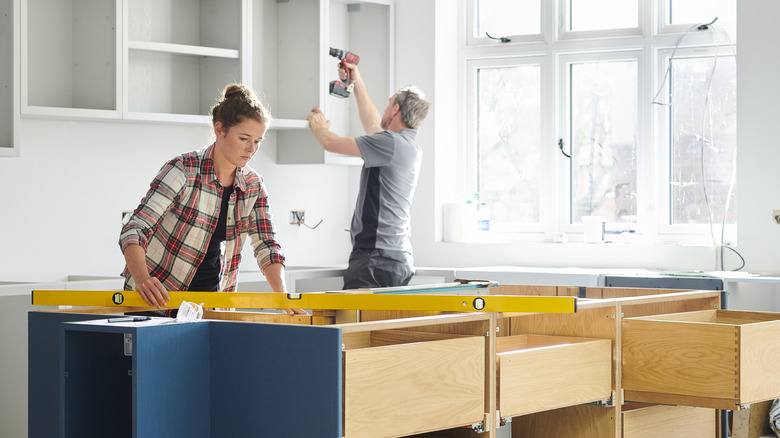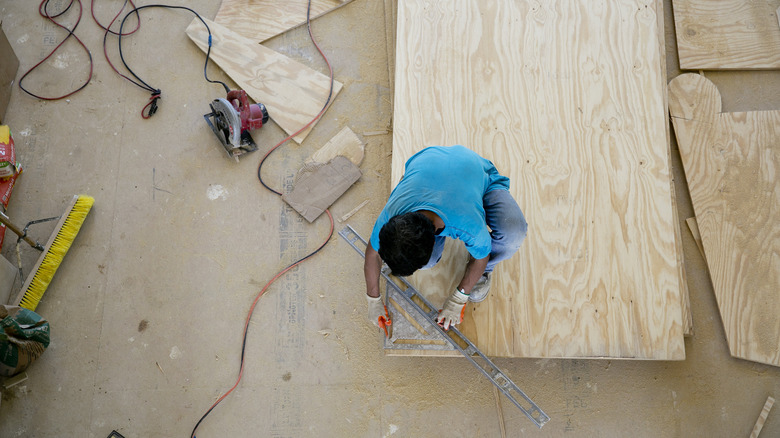Can You Build Your Own Cabinets (& Will It Really Be Cost Efficient?)
If you've ever wondered whether it is possible to DIY your own kitchen cabinets, it probably happened not long after you found out how much custom cabinets cost. It's easy to dismiss the DIY idea, assuming the high prices of cabinetry are a result of the high skill level required of cabinet makers. But the truth is that you can DIY your own cabinets, and you will probably manage to save some money in the process. When TikTok DIYer @xomacenna took the project on in 2022, she got a lot of attention from followers who seemed amazed and encouraged that it could be done. She built her own, including shaker doors and drawer fronts, and acquired a lot of skills (and tools) along the way.
Purchasing custom cabinets for an average-sized kitchen costs between $15,000 and $30,000. That's an average of $850 per linear foot, and included in that is a lot of materials, labor, and tools. A pro cabinet maker will also need to pay for a work vehicle, a commercial workshop, insurance, better tools than you're likely to have, and countless other expenses. Fine cabinet-making is a highly skilled profession, but you don't have to become a pro to make the best possible cabinets for your kitchen. You only have to learn how to make your cabinets on your budget.
Is it cost-effective to DIY cabinets?
Costing out cabinets can complicated, but rough estimates are useful. Since labor is 25% to 40% of the cost of custom cabinets, we rounded to one-third for labor and two-thirds for materials. You would typically need A- or B-grade ¾ inch plywood for the bulk of the carcass and ¼ inch lower-grade plywood for the backs and drawer bottoms. For shaker doors and drawer fronts like @xomacenna's, you'd add ¼ inch A or B-grade plywood for the panels, and solid boards (we priced 1-by-3 poplar) for the rails and stiles. Using materials estimates for base cabinet carcasses, which use more wood than wall cabinets do, we estimated just under $60 per linear foot based on current lumber prices.
We priced low-cost, reasonably high-quality tools the average DIYer would need but might not have. The total cost for a circular saw, saw track, pocket hole jig, table saw, router and table, miter saw, orbital sander, compressor, 18-gauge pneumatic nailer, and a cabinet hardware jig came to around $1,300. As for labor, let's assume you're building a 2-foot-wide cabinet in two eight-hour days. With an average labor cost of $276.25 per foot, you're saving $34.53 per hour. Even assuming you want the most expensive hardware, you would have a hard time spending $850 per linear foot on it, and your actual total cash outlay would probably be closer to $100 per foot.
Okay, but can I really do it?
If you watch @xomacenna's YouTube channel, it doesn't take long to realize that she's confident and determined, not at all intimidated by challenges like cutting the mortises and tenons for shaker-style cabinet doors. It takes a number of such skills to DIY a cabinet carcass and doors, but none of them is prohibitively difficult. The least familiar skills might be breaking down sheets of plywood according to a cut list, which is aided tremendously by a saw guide or track, and pocket hole joinery, which can be learned from a five-minute video. Making drawer fronts and doors could involve learning how to adjust and use a router table or a dado stack, which are mostly matters of practice and attention to detail.
There's no advanced carpentry or woodworking involved here, but there is a lot of learning to be done. And that might be what the answer ultimately comes down to: Can you make your own cabinets? Yes, absolutely, if you're willing and able to invest the time in learning some new skills. The other big requirements, which are closely related to each other, are patience and precision. In cabinetry, almost every cut should be pretty close to correct, or you'll have problems with things getting out of square or not matching other pieces properly. If you have the temperament for re-working things as necessary to make them fit well, you should have no trouble with making cabinets.


